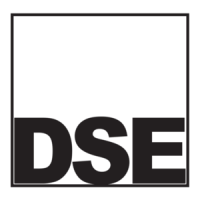
Do you have a question about the DEEP SEA ELECTRONICS DSE8610 MKII and is the answer not in the manual?
| Storage Temperature Range | -40 °C to +85 °C |
|---|---|
| Maximum Operating Altitude | 3000m |
| Analogue Inputs | 4 |
| Configurable Timers | Yes |
| Event Logging | Yes |
| Tier 4 Engine Support | Yes |
| CAN, MPU and Alternator Speed Sensing | Yes |
| Communication Ports | RS232, RS485, CAN |
| Protection Rating | IP65 |
| Display | LCD |
| DC Supply | 8-35V |
| Alternator Input Frequency | 50/60Hz |
| Operating Temperature Range | +70°C |
Clarifies notation conventions used throughout the manual for better understanding.
Provides definitions for technical terms and acronyms used in the manual.
Lists DSE publications and third-party documents referenced in this manual.
Details the structure and meaning of DSE8610 MKII product part numbers.
Specifies the operational temperature range for the DSE86xx MKII module and variants.
Lists UL specifications and requirements for the DSE8610 MKII module.
Details the specifications for the module's connection terminals.
Outlines the power supply voltage and current requirements for the module.
Details the measurement type, sample rate, and accuracy for voltage and frequency sensing.
Specifies the measurement type, sample rate, and accuracy for current sensing.
Details the specifications for various input types.
Details the specifications for various output types.
Lists the available communication ports on the module.
Explains how each communication port is used.
Describes the internal sounder for alarms and attention.
Details logged engine hours, starts, and accumulated power.
Provides physical dimensions and mounting details for the module.
Lists relevant industry standards and certifications applicable to the module.
Illustrates the rear module connections and identifies terminal functions with icons.
Details the pin assignments, cable sizes, and notes for module connections.
Provides typical wiring diagrams as a starting point for system setup.
Presents wiring diagrams for various AC topologies and earth fault configurations.
Illustrates typical single-line application diagrams for multi-generator systems.
Explains the function and operation of the front panel push buttons like Stop/Reset, Manual, Auto, Start.
Guides on navigating and viewing different instrument pages on the module display.
Explains how user-configurable LEDs indicate various functions and status.
Provides a quick guide to the module's basic operation.
Explains how to activate and use the Stop/Reset mode for the module.
Details how to operate the module in Manual Mode for generator control.
Details how the module operates the generator automatically in Auto Mode.
Details prime power operation and load sharing between generators.
Details fixed export operation for paralleling with mains and controlling power output.
Describes the inbuilt exercise run scheduler for automatic operation.
Details settings for MSC compatibility with legacy DSE controllers.
Explains dummy load and load shedding control features for managing generator load.
Describes how to send control commands to the module via SMS messages.
Details dead bus synchronising for rapid generator parallel operation.
Explains how the module handles and displays alarms, including silencing and scrolling.
Details warning alarms that draw operator attention to undesirable conditions without affecting operation.
Explains electrical trip alarms which latch and stop the generator in a controlled manner.
Details shutdown alarms which immediately stop the generator to prevent further damage.
Describes engine maintenance alarms based on configurable schedules.
Explains mains failure detection alarms (ROCOF, Vector Shift) that trip the generator breaker.
Combines warning trip and IDMT curve for thermal protection against over current.
Explains the IDMT curve for preventing alternator overheating due to short circuits.
Explains the IDMT curve for protection against earth faults.
Shows default IDMT tripping curves for Over Current, Short Circuit, and Earth Fault.
Explains the Fault Ride Through function to prevent generator disconnection during voltage dips.
Allows full configuration of the module via the display without PC software.
Allows configuration of parameters while the engine is running.
A checklist of essential checks before starting the system for the first time.
Outlines the four essential steps for achieving successful generator synchronisation.
Details the steps required for achieving successful load sharing between generators.
Lists common starting symptoms and their possible remedies.
Lists common loading symptoms and their possible remedies.
Lists common alarm symptoms and their possible remedies.
Lists common communication symptoms and their possible remedies.
Lists common instrument measurement symptoms and their possible remedies.
Lists common synchronising and load sharing symptoms and remedies.
Details broadcast CAN messages transmitted when J1939-75 is enabled.
Details engine instrumentation messages transmitted via CAN.
Information on purchasing connector plugs and packs from DSE.
Lists DSENet® expansion modules with their supported numbers and part details.
Provides guidance on the separate disposal of WEEE.